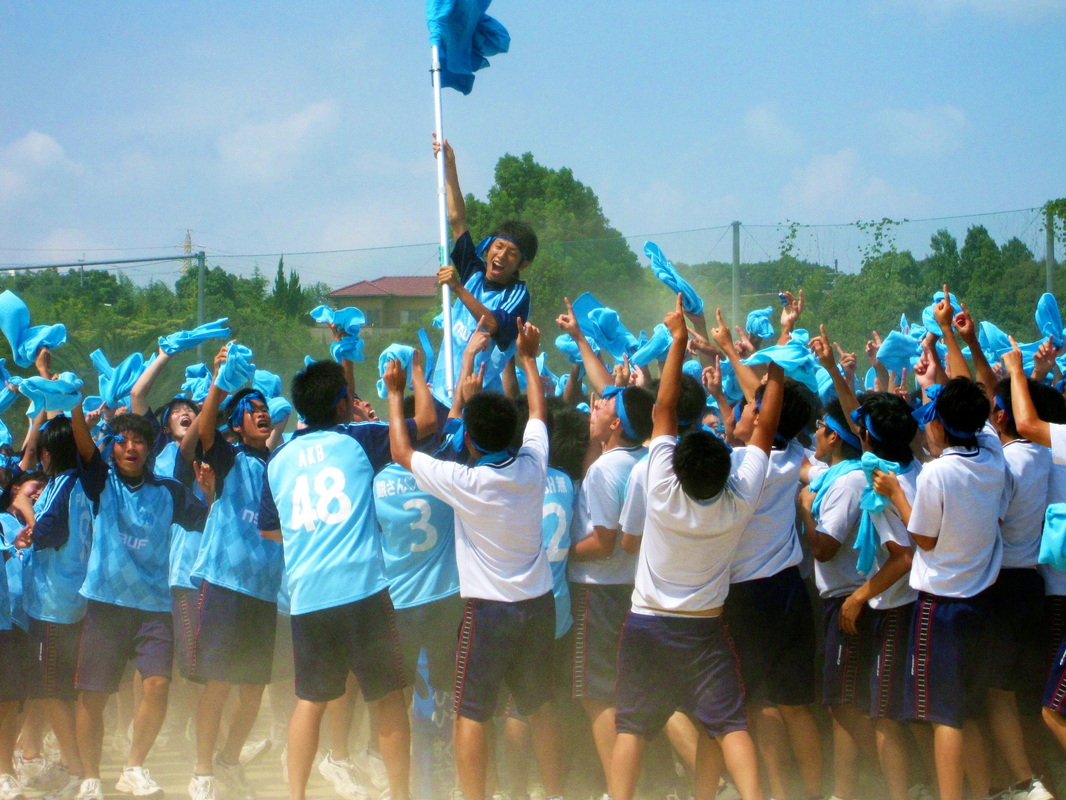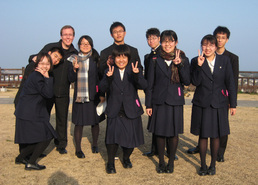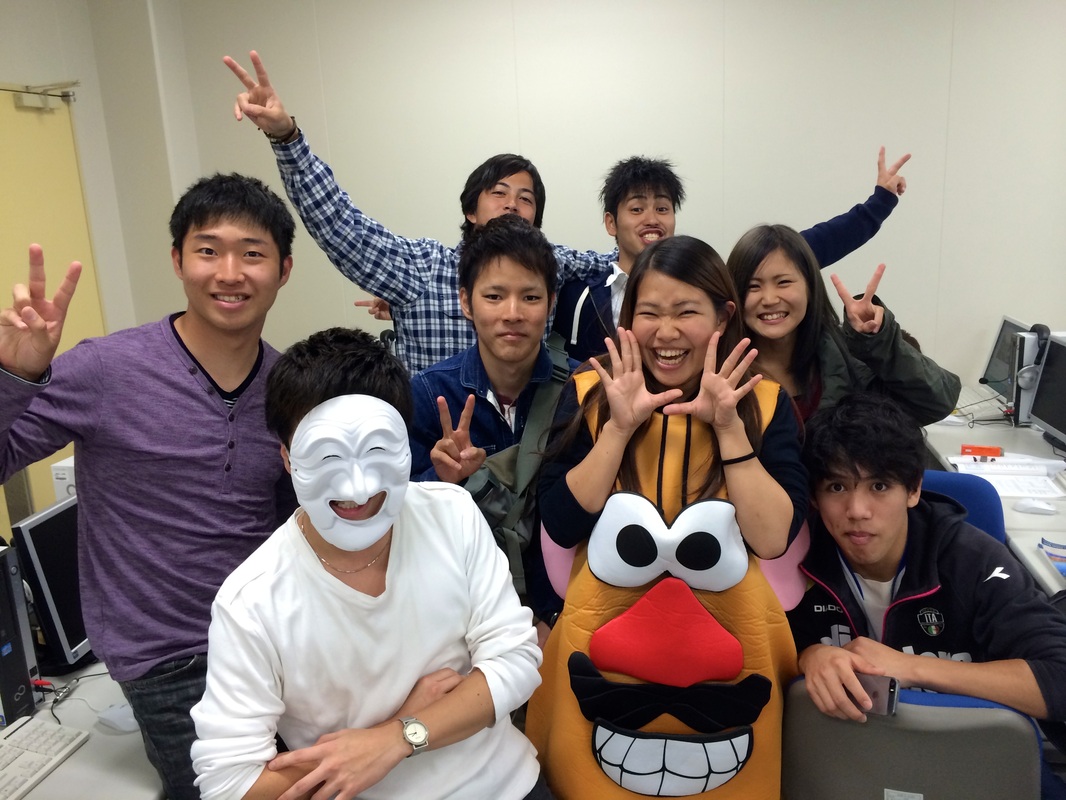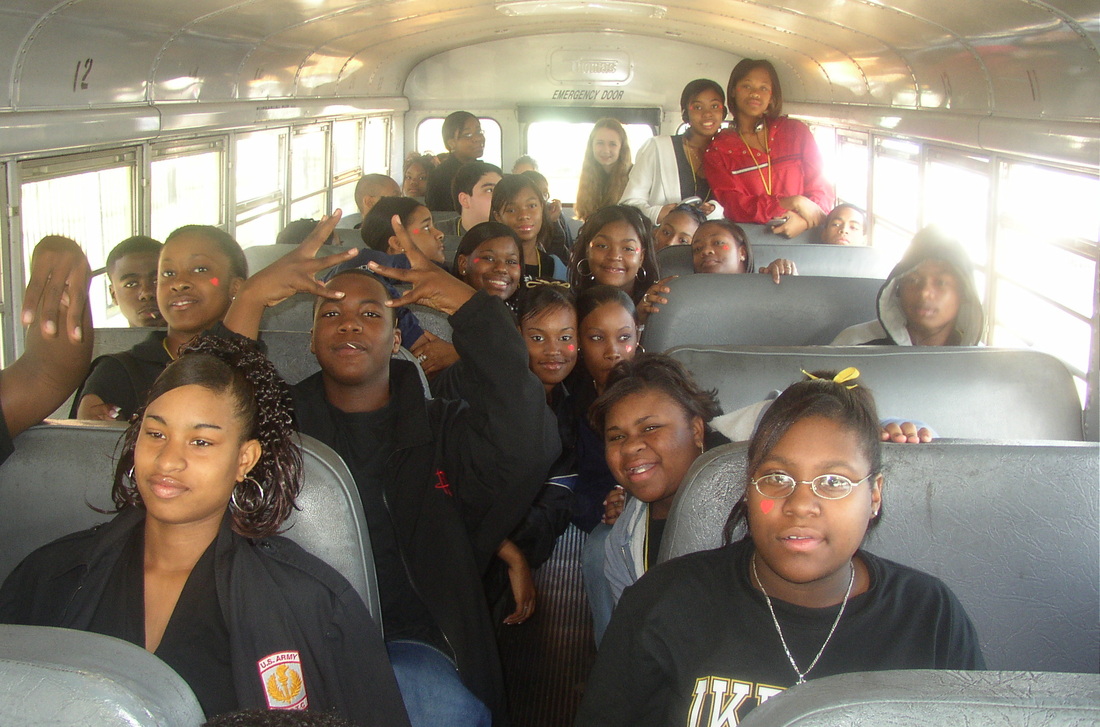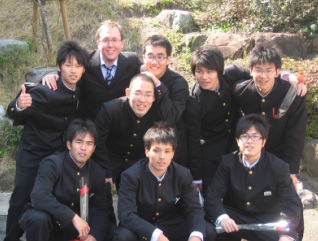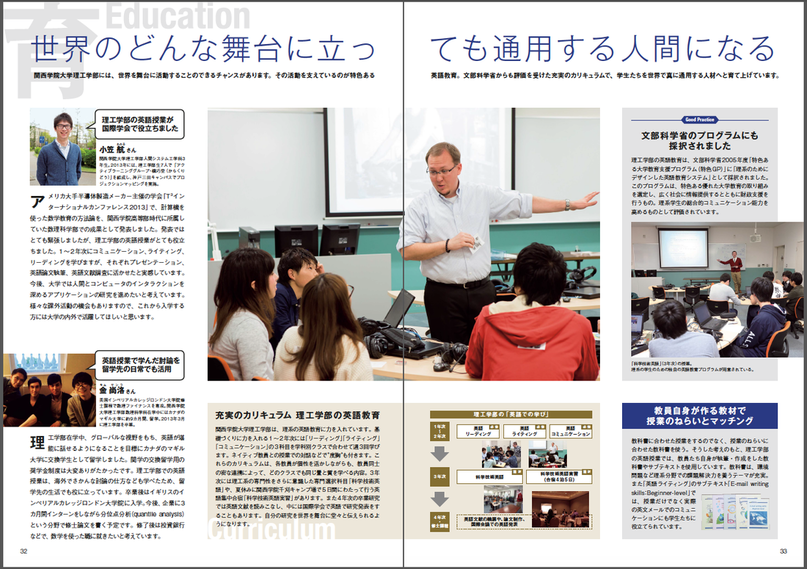Teaching Philosophy
|
| ||||||
"I believe that it is my first responsibility as an educator to create and facilitate a safe environment for learning and the expression of diverse and sometimes radically opposed ideas." Overall, my teaching philosophy can be summed up in three words:
Excite
|
Every teacher is a personality and has his or her own philosophy about teaching and learning. I have spent my life travelling, studying, and living in such culturally diverse countries like Japan, Germany, Florida, Texas, and Hawaii in the United States, Jordan, Korea, Thailand, Egypt and back to Japan this year. I believe that travelling and working in culturally diverse environments is one of the most effective ways of shaping a personality and a teaching philosophy.
Most people say that I possess an open, accessible personality which has been a major asset in my dealings with colleagues and students in a variety of professional contexts. I am aware of and sensitive to the problems and issues involved in inter-cultural communication and relations, at both personal and professional levels. I usually accept criticism and differences of opinions in a positive manner and I often learn from my colleagues, as well as from my students. While I have specialized in language teaching and language assessment and evaluation, more specifically, I am interested in ESP program development in marginalized populations, critical language pedagogy, drama as pedagogy in the second language classroom, and LGBT identity development as facilitated through language. Teaching English as a second language requires from me broad knowledge of many fields such as science and technology, business and computing, career and vocational education, mass media and communication, society and environment, philosophy and ethics, psychology, medicine, etiquette, literature, geography, history, culture, art, sports and recreation. I relate my personal knowledge and life experience to various topics, and I discuss these topics with my students in the classroom. I perform brainstorming, set the scenarios and arrange debates from various viewpoints. Such debates expand students’ knowledge about the world and improve their language skills. They also develop their imagination, creativity and critical thinking skills. Students study in teams and they learn from each other. Yet, before any learning can take place, I believe that it is my first responsibility as an educator to create and facilitate a safe environment for learning and the expression of diverse and sometimes radically opposed ideas. Taking a line from critical pedagogy, a classroom should be a place where everyone is equal regardless of sex, race, sexuality, religious affiliation, language, nationality, and so on, where everyone is encouraged to find and develop their own voices, equally weighted and yet distinct. Such a classroom environment can only lead to greater diversity of information and ideas, where not only learning can take place but also where social justice can shine. In such a classroom, passions can lead to actions and actions have the potential cause progressive change in the world. Once a safe space is created, I also believe that all students acquire some basic knowledge about life and their relationship with the environment. Language is a means of learning about the world so I believe that language is most effectively mastered in the meaningful context which stimulates students to think and study through the use of the target language. My teaching experience showed that in-class examples and discussions, case analyses, experiential exercises and class projects enable students to feel more confident and their learning becomes not only interesting but also efficient. They find information they need and solve specific problems in their target language. Specific tasks that I usually give to my students include identifying resources to be used to collect information, generating possible solutions, analyzing the solutions and presenting the solutions either orally or in writing. In my classroom students continually interact with each other, try new things, build connections, share ideas, and learn from each other. It is also important to teach students how to study. Students should know some basic facts about language acquisition. In fact, they do not 'learn' a language; they 'acquire' it. Acquiring a language means that students 'pick up' certain skills, not just memorize information – grammar rules, words, phrases and syntactical structures. Acquiring a language is like acquiring swimming skills: the person must not only understand the ideas and concepts, have information at hand; the person must also make his or her body adapted to using that information in physical activity. In the case of language acquisition, the physical activity involved is listening, speaking, reading, writing and body language (or, to be more precise – paralanguage, i.e. mimics, gestures, facial expressions and many other paralinguistic aspects). I explain to my students that they need not only to memorize and understand but also to practice in order to 'pick up' certain skills. Language is a part of our thinking, therefore, my task is to develop learners’ thinking skills. I try to ask my students critical thinking questions from all levels. Some of my questions can be challenging in content or in form; some other questions can be difficult because students’ vocabulary is not rich enough. However, I always try to adjust questions that are age and level appropriate. At the beginner’s level I prepare responses to some of the most challenging questions by using yes/no or embedded questions. I use pictures, drawings and diagrams which help students to give the correct answers. Responses to these questions are generally right in the handout. At the intermediate level I put more emphasis on comprehension. This level shows that the student has understood the facts and can interpret them. Students are asked to classify, compare, contrast and illustrate. At the advanced level my teaching is based on directing learners’ attention to application, analysis, synthesis and evaluation. At this level students learn to solve problems by using previously acquired skills and experience. They learn how to classify, contrast, compare and categorize these facts; in addition, they solve problems and evaluate results. I believe that the quality of teaching has a significant impact on students' behaviour and motivation. Motivation is an unconscious, psychological process that varies by individual over time, and its degree usually depends on attitude. Both attitude and motivation are also social processes and they are influenced by individual experiences and cultural background of students. In my opinion, motivation can be generated through effective curriculum, good learning materials and teaching strategies. The teacher must gain the students’ attention by supplying them with stimulating activities and using a range of teaching strategies. Student motivation can be a difficult task for the teacher. My students usually perceive the content of my lessons as relevant to their objectives. I try to design learning objectives in such a way as to make them achievable and to continually build my students’ confidence. I motivate students by using various strategies such as learner-centred activities, cooperative learning, informal assessments and open communication. I also explain to my students why they need to learn certain things. Teaching of young people places me directly in the line of shaping their lives throughout education. I am an educator and a life-long learner therefore I have a passion for learning and learners. I believe that a true learner is not satisfied until he has shared all his knowledge with his students. Teaching is a consistent, two-sided process of learning and sharing. I often learn from my students by getting feedback from them. In addition, I believe it is important for me to talk with my colleagues to get support and feedback, to learn from their experiences, to be open to new methods and strategies, and to seek out professional development opportunities at conferences, workshops or seminars. With these ideas in mind, I believe that the call to teach and educate is one of the greatest missions in life and an extremely significant vocation. |
教員は、全員が異なる個性を持ち、それぞれの教育・学習理念を持っている。私は、ドイツ、米国内、ヨルダン、エジプト、タイ、韓国など、旅行・学習・生活を通して、様々な国の文化を学んできた。そのような、異なる文化、多種多様な環境下での経験は、自身の教育理念と私自身に大きな影響を与えている。
多くの人は、私のことを、広く寛大な心を持ち接しやすい人物だと言うが、それは、私が多種多様な異なる職場環境において、 同僚や生徒と円滑な関係を築く上での強みであると認識している。私は、起こりうる問題や、異文化交流上の人間関係やコミュニケーションにおいて、個としても、プロとしても、早期発見・解決に努めており、常に、他者からの批判や意見の違いを前向きに受け止め、多くの事柄を同僚や生徒から学んでいる。 私の専門は、言語教育、言語評価である。特に、 移民者への教育、クリティカルランゲージティーチング、第二言語習得環境下で行う演劇レッスン、個々の自己の確立に対して、言語を通して 手助けをすることに興味を持っている。 第二言語として英語を教えることは、文学、科学から芸術、職業指導に至るまで、様々な分野の、幅広い知識を必要とする。私は、自分の知識と経験を様々な話題に結びつけ、クラス内でディスカッションをさせたり、ブレインストーミングを行ったり、シナリオを設定した上での話し合いを複数の視点から行うなど、生徒自身の知識を広げると共に、言語の上達に繋がるように仕向けている。また、これらの活動を通して、生徒達は想像力を養い、理論的な思考や創造性も身につけ、お互いから様々な事を学ぶ機会にもなっている。 全ての教育の前提として、私には、多様で相反した意見や見解を示し、それらをお互いに学習できる環境を整え、作る義務があると考えている。クリティカルランゲージティーチングからの引用として、「教室内は全員が性別、人種、性的嗜好、宗教、言語、国籍などに関係なく同位であり、それぞれの相違や意見を探し、それらをお互いに尊重し合うことを支援する場である。」という一文があるが、私は、このようなクラスを作り出すことによって、多種多様な社会性を活かし、異なった様々な情報と意見をそれぞれより引き出すことが出来るというのは、生徒の積極性と、潜在的な世界の変革を生み出す原動力に繋がっていくと信じている。 また、このような環境を作り出すことにより、生徒達は基礎となる生活や環境に関する知識を身につけることが出来、言語を学ぶという行為を通して、自分自身の世界を広げ、そこから考え・学ぶという意欲を引き出すことが出来ると考える。 私の教育経験上、生徒はディスカッションや課題を通して学習に対する面白さだけでなく、生徒自身に言語に於いての問題解決に必要な情報を探させ、自分たちでの解決を促すことにより、生徒達には教室内での活動を通じて、自分の語学力の向上を実感し、自信に結びつけることが出来ると思う。そして、生徒達には、問題解決に向けた情報を集め、分析し、それをまとめた内容をオーラル又はライティングでの発表をすることにより、お互いに関わり合い、新しいことを試し、お互いの関係を築き、考えを共有するなど、互いの学習を助け合えるようになる活動が行えるよう、促している。 教育者として、どのように勉強するかと言うことを教えることも、重要な事であると考えている。言語獲得に必要な基本知識を生徒達は知る必要があるが、言語とは学習するものでは無く、獲得するものであり、言語を獲得するとは、単に言語に関して文法や語彙を記憶することだけでない。人が泳ぐことを覚えるように、身体と五感を駆使しながら、技術を得ていくことに似ている。言語獲得の場合は、これを、リスニング、スピーキング、リーディング、ライティングとボディーランゲージを通して獲得していくが、私は常に生徒達には単に様々なコトを記憶し、理解するだけでは無く、反復して行う練習を通して、言語の感覚をつかむことの重要性を説明している。 言語とは、私達にとって、思考の一部である。つまり、私の職務は、学習者の思考力を伸ばすことでもあると考えている。クリティカルシンキングが身につくよう、全レベルの学習者に対し、それぞれに見合った内容・語彙を駆使しながら学べる内容を用意するよう、心がけている。たとえば、初級者には、少ない語彙や知識を生かせるようにYes or Noで簡易に答えられる設問を多数用意し、それをもって正解に導けるよう、答えの幅を狭めていけるようにした絵や図表を用意したりする。中級者には、自身の理解や知識を通して真実が何かを洞察し、解釈できるように比較、見当等を行わせる。また、上級者には、自身の経験や技術を通して、応用、分析、統合、評価が出来るようになるよう、導いている。 教師は、どの学習方法を使い、何を組み合わせると、より効果的な学習に繋がるかを常に考えなければならない。これらは生徒の年齢、今までの教育や教養、生徒の人数や内容等によっても、柔軟に変容させ、応用すべきである。 私は、教育の質とは、生徒の行動と意欲によって、違いが出ると思っている。学習に対する意欲は、無意識レベルでの個人差があり、環境によっても差が出てくるもので、態度や意欲は生徒の文化や個々の経験によって、様々である。しかし、効果的な教材を用い、カリキュラムと授業計画を組むことによって、意欲向上を達成させることが出来ると思う。教師は、意欲を引き出す活動や授業計画を組むことにより、生徒の関心を得られるだろう。 生徒の意欲を引き出すのは、教師にとって、難しい作業の一つでもある。 私は、学習目的自体が生徒達に自信をつけることに繋がるように心がけながら、授業計画を練っている。様々な学習方法を用いることにより、生徒の意欲的な態度を引き出し、また、生徒には何故それを学ぶのかを説明している。これらを通して、私の生徒は、大抵、授業内容が自分たちの目標に関連があることに気づいているようである。 私が良く直面する解決するべき問題は2つに分かれると思っている。一つは、コミュニケーションにまつわる事柄で、生徒の出席率、宿題、不満、カンニングや、攻撃的になるなどの行動異常などであり、もう一方は、授業の教え方や、教材、テストや評価など、言語教育と学習について関連する事柄である。全ての言語教育者は、教育・学習レベルの如何に関わらず、これらの問題を常に解決していかねばならない。 若者を教えるということは、彼らの人生の中に教育を通し、直接私が関わっていくことであると思う。私は、教育者であり、生涯を通しての学習者である。それ故に、私は学習と学習者に対して、情熱を持ち続けている。真の学習者とは、彼らの知識を生徒達と分かち合うまで、決して満足しない人達のことを指し示すと思う。又、教育とは、一貫した学習と学習内容の共有という二つ面から成り立っていると考えており、私は生徒達からのフィードバックを通して、様々なことを彼らから学んでいる。それに加え、教育者にとって、同僚と話をし、周囲のサポートとフィードバック、他者の経験を知ることも大切なことであり、新しい指導方法などを受け入れ、より専門性を高めるために学会やセミナーに参加することも重要であると考えている。 これらの考えを通し、私は「人に教育を施す」ということは、私の生涯を通して行う重要な使命であり、天職であると信じている。 |
Personal Teaching Narrative 「私の教育歴」sThere were no bells in my school. Before the end of each period, I had to do one of three things: look at my watch, hope that the clock on the wall wasn’t losing time, or wait for that all too eager student to put away their things, signaling the end of class. I then transformed from classroom manager to hall monitor while melting into the halls to get a jump-start on the social amalgamation that was “class change.”
That was my first year of being a high school English teacher, and I found myself wanting more. I wanted more than the painted, cinder block walls that teachers so artfully try to camouflage with bulletin board paper, more than an educational system that was all too often geared toward punishment and state standards rather than praise and building intrinsic motivation, more than what my limited teacher education had lead me too. But ultimately it was while standing amongst those cinder blocks that I reached a turning point in my life as a teacher and realized that I was lacking not only experience in a classroom but also experience with other cultures and people who spoke a different language than myself. Before I get to that turning point and what it meant to me as a lifelong language teacher and learner, I want to go back to where my educational foundation began, and introduce you to a recurring character in my life. Blountstown, the place of my childhood, is that character. The familiar story of Blountstown is far older than my own. To this day, I remember my Elementary music teacher, Mrs. Kimbrell’s rendition of John Blount, the Seminole Indian Chief who guided and assisted Andrew Jackson in the invasion of Spanish Florida. Blount was granted a reservation along the Apalachicola River in the newly acquired Florida panhandle, four miles by two miles square. “Thus,” Mrs. Kimbrell uproariously concluded in every telling, “Blount’s town was born.” As the most influential character in my life, Blountstown ingratiated itself into every facet of my being. Today, I represent the oldest son of The high school P.E. teacher and confidant of every student in Calhoun County, Florida for the last 30 years, my mother, and the high school Ag teacher/ County Extension Officer/ highest ranking army officer in the area/local hero who served six out of the last ten years in Afghanistan, my father. It isn’t an exaggeration to say that my family is a Blountstown institution, an institution that always seemed a bit inaccessible. I tell you about Blountstown to illustrate two seemingly dissident aspects of my language teaching style. I both believe that teachers should instill in their students a strong foundation in the basic skills of listening, speaking, reading, and writing as well as inspire their students to go beyond those basics. In Blountstown, I was first influenced by teachers who drilled us in sentence structure and mechanics daily. We diagrammed sentences while memorizing over-used and under appreciated selections from Shakespeare’s texts. At the time, I was never aware of the teaching strategies involved and those teachers had little interest in making us aware. Yet, hindsight being what it is, I consider myself lucky to have been a student who was intrinsically motivated, while students around me grew frustrated because they couldn’t see a connection between instruction and purpose. Nevertheless, I still see value in having a strong foundation in the basics of syntax and grammar, knowing also that I cannot use this case as an example of an effective teaching style. Secondly, other teachers that, like myself, had outgrown the bounds of rural north Florida also influenced me. While they instilled a foundation in the basics as well, they also taught from a perspective of inspiration rather than education. Instead of having us only memorize and recite Shakespeare or dire moments of WWI, they gave us the tools to recreate it, to act it, to experience it. Those rare teachers facilitated my imagination and instead of only receiving information, I was generating it. I learned how powerful student creation, production, and ownership can be in a classroom. At university I majored in communication arts, theatre, and English. I had always known that I wanted to teach English, but I was also aware that only reading and writing wasn’t what excited me. It was in college that I began to synthesize my love for literature and my passion for theatre. For my theatre capstone project, Page to Stage, I compiled and directed a selection of pieces from my university’s World Literature course accompanied by a packet of educational material for use in the secondary English classroom. Besides being influenced by my theatre director and other professors, I was mostly influenced by the course work in my American Renaissance class. Surveying works from Emerson and Thoreau to Whitman, the canon became a metaphor for the pedagogy of my high school education. While Emerson very much adhered to the rigid style and emotional constraint of his contemporaries in England, there was a tangible difference in Thoreau’s style and his casting off of tradition for a synthesis with the greater world around him. In Whitman, all the rules of civility and tradition were replaced with raw content and language for language’s sake. For Whitman and for myself, the message became more important than the means, and as in life, the medium in which we communicate isn’t as important as the communication itself—all this from the perspective of a student. It was then that I moved to Houston, Texas to begin my time as a high school English teacher. I would love to say that my time was filled with creative and inspirational lessons that moved students to change the world while learning the difference between present progressive verbs and gerund phrases, but I can’t. Because my educational background focused more on content rather than pedagogical practice, every day was spent managing classroom behavior—all of my grand ideas wasted. Had it not been for my struggles in the first year and some pretty inspirational role-model teachers, I would still be struggling with how to get my students to be quiet as opposed to motivating them to want to listen. It was here that my ideas practices regarding student motivation were developed. This is where I reached my first turning point as a teacher. Through that first year, my first epiphany came when I learned that not every student was like me. I know that seems like common sense, but it struck me as profound at the time. Realizing and accounting for the fact that every student had a different level and type of motivation were the hardest parts of teaching for me. Truly, every task had to be individualized, and my attention to every student had to be focused. I could not be that great orator making generalized proclamations from a pulpit, but instead I had to become a surgeon meeting my students at each of their levels of motivation. While the job became much more time consuming in the second year, I became more intuitive and came to read my students attitudes much quicker than before, and before long, content made it’s way back to the table. Another issue that I faced in my first year as a teacher was that the students treated me like an outsider who literally communicated in a different language. Of my students, 60 percent came from homes where English was not the first language. My job was to teach secondary English literature; yet I found it necessary to modify my lessons 80 percent of the time to accommodate students who, with respect, should have been placed in ESL classrooms. Later, I found that in most cases, students declined enrollment in ESL due to the stigma attached. In the end, I picked up a few words of Spanish, and I slowly won the respect of my students. I even produced a few one-act plays in my classroom, not quite Shakespeare, but you would have thought it was. Not without its moments or tears, I look back at that year as one of my best, and one of my greatest learning experiences. The next turning point in my life as a language teacher was in Japan. Without any prior Japanese language skills, I applied to and was accepted into the JET Programme. For five years, my job, as a part of the Japan Exchange and Teaching Programme, was to teach EFL at an academic high school. Weekly, I taught over 400 students in oral communication, advanced presentation, and senior writing classes. My extra curricular activities included, among others, coaching the English speech and debate teams. I also volunteered with the international center, each year writing and directing a bilingual play that coincided with the annual international festival, and I offered weekly English conversation classes to adult groups. My problems in the classroom here were two-fold: for one, my lack of Japanese and the students’ low levels of English didn’t allow for direct communication at a level that I was used to, and secondly, up until this point I had had very little experience teaching ESL listening and speaking skills. With almost no ability to communicate orally, I instinctively began to recognize the paralanguage all around me, pitch, rhythm, intonation, not to mention gestures and body positioning. I gained insight in what it must have been like for my ESL students in Houston and an appreciation for language acquisition in an emersion atmosphere. As for my experience in teaching listening and speaking skills, I found that holistic, task-based approaches worked best. When taught in isolation and without a task-oriented theme, students showed lower retention rates. In assessing student retention of vocabulary and other skills acquired in the listening and speaking activities, I used a variety of methods from standardized testing, interviews, student produced skits, and observation of classroom discussions. It was clear that the standardized testing didn’t accurately measure student achievement nor did it always parallel observed classroom behavior. Overall, now as a university English language professor in Japan, I have been a language learner all my life and a teacher for sixteen years. In that time, I have been fortunate enough to spend many of those years travelling, learning, and teaching around the world from Florida to Texas, Mexico, Brazil, Trinidad and Tobago, across Europe, Egypt, Jordan, and into the East, Thailand, Malaysia, China, Korea, and Japan. Coming from the socially conservative climate of a small, rural town in north Florida, my learning curve for other cultures and peoples was steep. My perspective on the world has always come from a place of respect and amazement, and it is with this sentiment that I will continue to learn and teach in the language classroom. - Matthew Barbee |
"My perspective on the world has always come from a place of respect and amazement, and it is with this sentiment that I will continue to learn and teach in the language classroom." |

